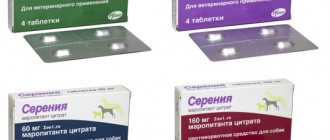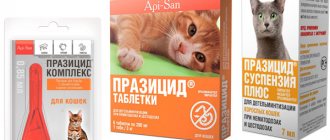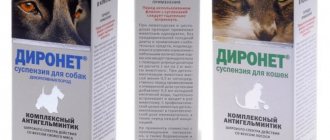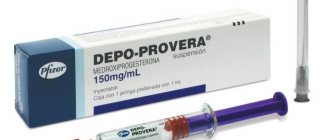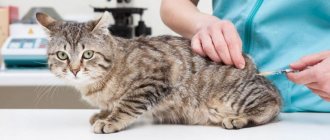For some acute diseases, cats are prescribed broad-spectrum antispasmodics, which are highly effective and relieve all inflammatory processes. This is exactly what the drug “Papaverine” is, which has now become very widespread. It reduces the tone and activity of muscle tissue.
This happens due to vasodilation. Due to the action of the drug, it is possible to eliminate the spasm and get rid of the pain syndrome. But is the drug really that good? Does it have any nuances and contraindications? Read about this and much more in our article.
Indications for use of the drug
The drug is widely used for:
- spasms of smooth muscles;
- urinary system infections;
- intestinal colic;
- diseases of the gastrointestinal tract;
- urinary tract spasms;
- cholecystitis;
- pylorospasm;
- to lower blood pressure.
Sometimes it is prescribed to animals that suffer from bronchospasm and spasm of peripheral vessels. The medicine can solve a number of problems that arise during illnesses. It helps relax the muscles and walls of the bladder, uterus, bronchi and many other organs.
Reference!
Sometimes an injection of “Papaverine” is administered before any surgical intervention or urological manipulation, as well as to relieve acute pain during the treatment of urolithiasis.
The advantage of using this drug is the painlessness of injections and the rapid distribution of the active substance in the tissues, which helps to quickly relieve pain. The injection is not painful and does not cause anxiety or discomfort in the cat.
Description of the drug
The therapeutic dose of Papaverine exceeds the toxic dose by 28.8 times, which allows it to be classified as low-toxic and used in veterinary practice.
The opiate alkaloid papaverine has a relaxing effect on the smooth muscles of the hollow organs of the urinary, respiratory, and digestive systems. In addition, the substance has a hypotensive (lowers blood pressure) effect, because it relaxes the muscle tissue of blood vessels.
The drug has little effect on the central nervous system, but if the dose is exceeded, a sedative effect may be observed. Accordingly, taking Papaverine helps to relieve:
- spasms;
- painful sensations of spasmodic and non-spasmodic nature.
In addition, it activates blood supply to tissues.
Cystitis, urolithiasis and other indications
Veterinarians prescribe a myotropic antispasmodic to cats for the following pathologies and conditions:
- spasm of the urinary tract;
- intestinal colic;
- cholecystitis;
- bronchospasms;
- pylorospasm;
- urolithiasis disease;
- spasm of peripheral vessels.
Papaverine belongs to the group of non-selective (non-selective) neurotropic antispasmodics. This means that the drug provides a therapeutic effect by disrupting the transmission of nerve impulses in the autonomic nerve ganglia or fibers innervating smooth muscle tissue.
To facilitate surgical and diagnostic procedures, veterinarians sometimes administer Papaverine to animals.
Pharmaceutical forms of “Papaverine” for cats
There are three forms of drug release:
- an injection solution, the antispasmodic effect of which lasts from six to eight hours, is packaged in glass ampoules of two milliliters, and ten such ampoules are placed in one box;
- tablets are used less frequently due to the fact that their analgesic effect occurs very slowly, packaged in 40 mg in separate packages;
- rectal suppositories (twenty milligrams each) are used if it is not possible to administer an injection and it is not possible to give the animal a pill.
Release form, composition and mechanism of operation
“Papaverine” is supplied to pharmacy chains in tablets, injection solution and rectal suppositories. All these forms of release are successfully used for the treatment of various diseases in cats. The composition contains the main component called papaverine hydrochloride. Additional ingredients are purified water, talc, magnesium stearate and potato starch. With the help of the medication, it is possible to reduce the intracellular calcium content, relax smooth muscles, and dilate the arteries. Papaverine helps increase blood flow and reduce excitability.
Instructions for use
In order to prevent negative consequences after using the drug, you must strictly follow the instructions for use, which must come with the medicine.
Attention!
“Papaverine” can be used with other types of analgesics. Do not use the drug for preventive measures under any circumstances; it can only be used for the treatment of acute diseases! It is forbidden to give the product to young kittens under six months of age.
Pharmacological effect of the drug: hypotensive and myotropic antispasmodic.
Medication dosages
One milliliter of the drug contains twenty milligrams of the active substance (papaverine hydrochloride), special water for injection, D, L-methionine and disodium edetate. The dosage is always chosen only by the doctor. He does this based on the clinical picture of the cat’s disease, the form of the drug, the age and weight of the animal.
- In the form of injections, it is recommended to administer only 0.01-0.05 grams to cats, subcutaneously, intramuscularly, twice a day.
- If it was decided to use tablets, they are used in an amount of 1.2-1.5 milligrams per kilogram of animal weight, orally, twice a day.
- Suppositories (one or two milligrams per kilogram of weight), twice a day, but it is allowed to use up to four pieces per day.
Where and how to inject?
The medicine can be administered subcutaneously (into the withers), intravenously and intramuscularly (into the thigh).
The injection should be administered by a doctor in a veterinary clinic, so that the animal does not experience stress from an incorrect injection and the owner’s fear of injecting this same injection, and also to prevent injury to the pet.
In the hospital, cats behave more restrained and allow the necessary manipulations to be carried out, but at home, realizing that the person feels sorry for him, they can run away with a needle in their body or even bend it, which can lead to injury to the animal.
An incorrectly administered injection can harm your pet, so its implementation must be approached very responsibly and seriously.
Well
The course of treatment is always determined only by the attending veterinarian. The duration of medication depends on many factors, the main of which is the stage of the disease and its complexity. Typically, the course of use of the drug does not exceed seven days, but there are also more advanced cases when the period of taking the drug is increased.
Reviews
Owners
Carolina, 34, Kovrov:
“I give my cat Papaverine when she starts screaming in the litter box. I have to give her medications regularly because she has severe inflammation in her ureters, bladder and kidney stones. I give papaverine according to the regimen recommended by the veterinarian.”
Pavel 32 years old, Orel:
“My wife and I invited guests to our new apartment. The table was set. Our Briton Timokha loves to eat. Therefore, he sucked up to all the guests. Someone will give you a piece of sausage, someone will give you smoked fish...
By morning the cat became very ill. The veterinary clinics are all closed, and Timofey is fading away before our eyes. It's good that my friend is a therapist. He advised giving the pet ½ tablet of Papaverine. He got better, but since then I lock him in the bedroom when guests come.”
Alina, 43 g, Bobruisk:
“Papaverine became firmly established in our cat pharmacy 1-2 years after Murcello was neutered. Often he cannot go “small”. He yells, but it makes no sense. If you give him half a tablet, after a while he will pee freely and walk calmly until the next exacerbation.”
Veterinarians
Tatyana, 35 years old, veterinarian:
“Often owners give cats medications without prescription. It is impossible to count how many pets are then brought in with an overdose of Papaverine. This medicine should not be given randomly. Just the other day we failed to save an old cat. She died in my arms."
Kirill, 44 years old, veterinarian:
“I use Papaverine as a premedication before surgery on the urinary system in cats. It’s much easier to work with - the pet becomes calmer, a little anesthetic is required, and this causes less harm to the body.”
Contraindications
The drug has a large number of contraindications and side effects. It is imperative to study them before treating your pet with it. “Papaverine” should not be used for:
- liver failure;
- glaucoma;
- shock and stress;
- dysfunction of the adrenal glands.
It is allowed to be used with caution in cases of tachycardia and arrhythmia, but after administration the animal must be monitored. Do not use in old age or young kittens (up to six months).
Typically, animals tolerate the effects of this antispasmodic substance well, but there are cases of individual intolerance and some complications in the form of side effects.
Possible side effects:
- nausea;
- apathy, drowsiness;
- constipation;
- aggression and increased nervousness;
- heavy sweating;
- disturbances in the functioning of the heart;
- decrease in blood pressure.
Most often, side effects are observed only in cases where the dosage is exceeded. Sometimes, a drug is categorically unsuitable for an animal, but there is no apparent reason for this. In this case, you need to consult a veterinarian about replacing the drug with another one containing a different active ingredient.
When is medication not prescribed?
The drug is not prescribed for liver pathology.
It is prohibited to give injections, give tablets and use suppositories when the cat has the following conditions:
- allergic reactions to individual components of the pharmaceutical product;
- disruption of the cardiovascular system;
- liver failure.
There are also situations when Papaverine can be used with special care:
- being in a state of shock;
- renal and adrenal insufficiency.
Possibility of overdose
Important!
You cannot use “Papaverine” without consulting and prescribing a veterinarian!
Due to incorrect calculation of the volume of the drug per animal weight, an overdose may occur. Its consequences may be:
- loss of vision (temporary or permanent);
- arrhythmia;
- disturbances in vision (double vision);
- headache, nausea;
- paresis of the hind limbs;
- strong sedative effect;
- decreased excitability of the heart muscle.
In case of overdose, you must immediately stop using the drug and remove it from the body as quickly as possible and ensure that blood pressure is maintained. Gastric lavage (when taking pills) and enterosorbents are prescribed. Do not let the animal eat until it has been examined by a specialist.
Side effects
Negative reactions can occur due to an overdose of the drug or due to the individual characteristics of the cat’s body. They appear in the form:
- arrhythmias;
- disturbances in the conduction of electrical signals (blockades);
- dyspeptic disorders: nausea, vomiting, stool disorders;
- general weakness, apathy;
- aggressive behavior, increased nervousness;
- reducing pressure to critical levels;
- hyperhidrosis.
The higher the dose of the drug, the stronger it affects the central nervous system, providing an inhibitory, sedative, and hypnotic effect. If the duration of treatment is exceeded, episodes of disturbances in motor activity and thought processes are observed. Over time, they develop into a stable pathology.
What to do in case of an overdose, how to relieve spasm and lethargy?
Some owners describe the condition after a drug overdose as inappropriate behavior, a frozen gaze, lethargy to the point where the animal freezes in an uncomfortable, unusual position, stops responding to a voice or name, and refuses food and water.
There is no antidote to the medicine. If your pet experiences side effects after administration of Papaverine, you should:
- stop the drug;
- rinse the stomach;
- give activated carbon;
- convenient to lay and monitor the condition.
In case of severe overdose, death may occur due to cardiac or respiratory arrest.

